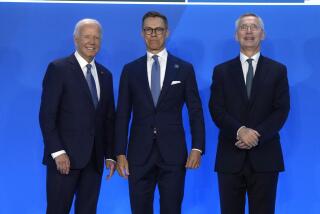Triumph in Washington . . .
- Share via
These are days of triumph for the Reagan Administration. Secretary of State George P. Shultz, after meetings with Soviet Foreign Minister Eduard Shevardnadze in Geneva, announced that the superpowers had completed an agreement to eliminate all intermediate-range nuclear missiles. The treaty is expected to be signed by President Reagan and Soviet leader Mikhail S. Gorbachev during a summit meeting next month in Washington.
The agreement is not the be-all and end-all of arms control. The superpowers will still have thousands of tactical and strategic warheads pointed at each other. But the treaty would, for the first time, eliminate an entire class of offensive missiles--those with a range between 300 and 3,000 miles, most of which are deployed in Eastern and Western Europe. It could--although this is far from certain--also pave the way for a far more important follow-up agreement on intercontinental-range strategic weapons.
There are still some problems, however, which should not be minimized. For the past few weeks the superpowers have been in agreement on the general provisions of the agreement, but have been tussling over some very real problems of verification--the mechanics of each side’s making sure the other isn’t cheating.
Shultz said Tuesday that the only remaining chore was to work out exact treaty language--a job that the secretary of state said “others will be able to do.” Those who followed the tortuous course of earlier U.S.-Soviet arms control negotiations can testify that it is the details, not the sweeping generalities, that tend to cause problems. It was, for example, imprecise wording in the SALT I treaty of 1972 that allowed the Soviets to build the super-missiles that Washington now considers especially threatening.
The problem is not only one of treaty substance, but of ratification by the U.S. Senate.
Public opinion polls, even those taken by conservative organizations, show the American people clearly in favor of the treaty as they understand it. A whole squadron of Republican stalwarts--including former President Nixon, Henry Kissinger and Brent Scowcroft, who has advised President Reagan on strategic arms--favor ratification despite their personal doubts about certain aspects of the agreement.
But the U.S. Senate is going to take some convincing that Soviet compliance can be verified. Some of the opposition comes from conservatives who really don’t want any agreement. But such responsible people as Sen. Sam Nunn (D-Ga.), chairman of the Senate Armed Services Committee, also have expressed concern that the Administration was negotiating under the pressure of a summit deadline and might as a result be too lax on verification arrangements.
Shultz and other Administration officials must be prepared to undergo close cross-examination on whether the U.S. negotiators have made sure that all the i’s are dotted and all the t’s are crossed. If the treaty passes the test, Washington and Moscow should find it easier to go on to the next step--a 50% cut in strategic nuclear weapons that would involve some of the verification problems that have supposedly been solved in the negotiations over medium-range missiles in Europe.
More to Read
Sign up for Essential California
The most important California stories and recommendations in your inbox every morning.
You may occasionally receive promotional content from the Los Angeles Times.













